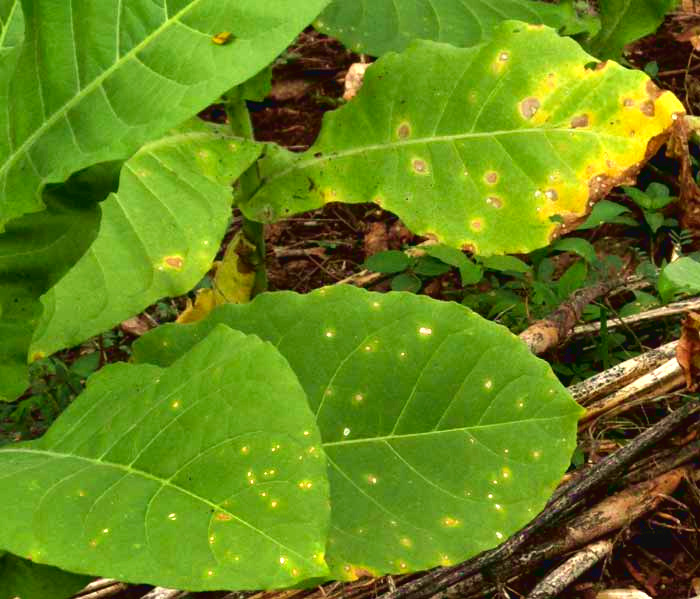Excerpts from Jim Conrad's
Naturalist Newsletter
from the June 14, 2018 Newsletter issued from Rancho Regenesis in the woods ±4kms west of Ek Balam Ruins; elevation ~40m (~130 ft), N~20.876°, W~88.170°; central Yucatán, MÉXICO
TOBACCO FROG-EYE LEAF SPOT
In the garden I grow a few tobacco plants, not only to show visitors -- who seldom can identify these examples of one of the world's most famous plants -- and for making nicotine-based insecticide. Lately most of the plants have developed small, yellowish-to-white spots like those seen below:

In that picture, the front leaves show new infections, while the leaf in the back with larger spots shows the disease at a more advanced stage. You can see that as the spots enlarge the leaf surface between spots yellows, and eventually the yellow areas die, turning brown and dry. A close-up of a leaf spot is shown below:

Especially at the dead area's bottom boundary you can see a fringe of tiny, slender, brownish, hairlike items. That's fungal hyphae advancing into the tissue. In the spot's center, what looks like black lint is mature hyphae producing spore-producing stalks.
This fungal disease was easy to identify, first because there's plenty of information on the Internet about tobacco diseases, plus the disease commonly occurs in the tropics worldwide, as well as to a limited extent in the Temperate Zone.
In English the fungus often is known as Tobacco Frog-eye Leaf Spot. It's CERCOSPORA NICOTIANAE, the species name nicotianae referring to the Tobacco plant, Nicotiana tabacum. However, the fungus doesn't restrict itself to Tobacco, but rather also infects many other members of the Nightshade or Potato Family, such as tomato, eggplant, and weed species.
Spores are spread both through the air and in soil, maybe even by hitching rides on seeds of diseased plants. Despite the disease's common occurrence, it's not nearly as deadly as certain others. Infected leaves often are included during sales of the leaf, and end up in tobacco products. Diseased leaves produce what's considered a lower-quality tobacco smoke, because of the leaf's reduced alkaloid and sugar content, among other things, and an increase in nitrogen content.
Tropical air and soil are so full of Tobacco Frog-eye Leaf Spot spores that's very hard to protect plants from it. Two common-sense measures against it are to remove and burn contaminated leaves, and use trickle tape irrigation, because watering from above splashes spore-rich soil onto the leaves.